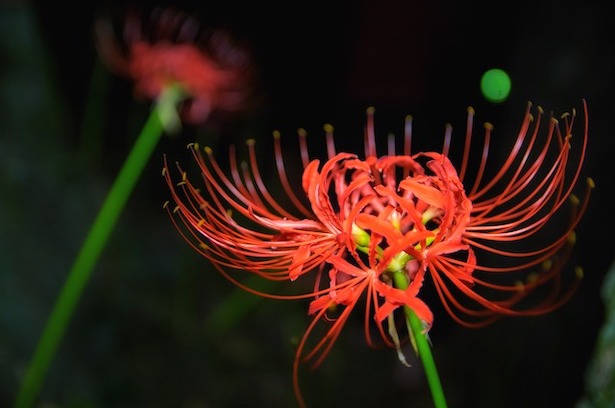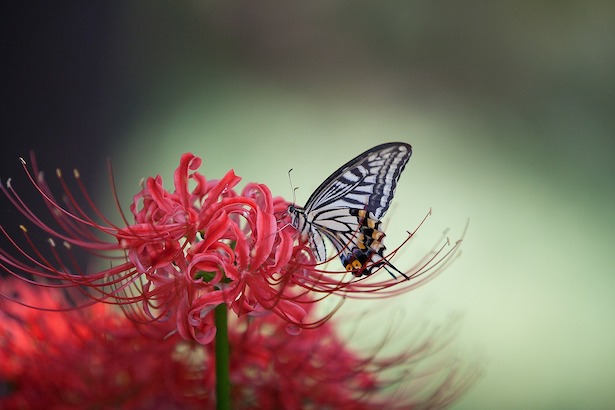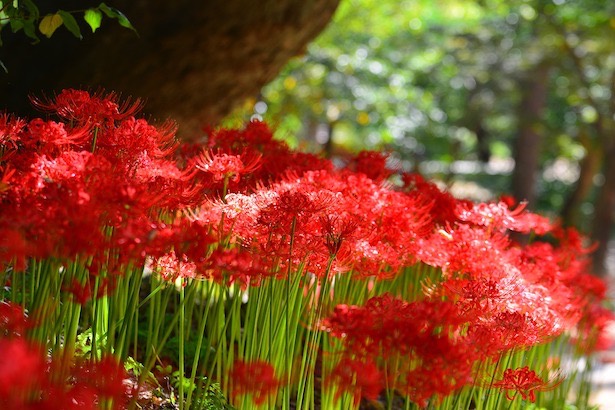The red spider lily or lycoris radiata, is a bulbous perennial flower that is known for its stunning coral red clustered flowers with a golden sheen that are enveloped by long red stamens. The red spider lily is known by a number of names, including red magic lily, red surprise lily, hurricane lily, hell flower or equinox flower.
Lycoris radiata is part of the Lycoris or spider lily genus, which contains golden, pink and white spider lilies. However, the red spider lily is by far the most famous specimen of the Lycoris genus. The Lycoris genus is part of the Amaryllis family of plants.
While native to the Himalayas, especially to the area close to China, Burma and Nepal, spider lilies were exported to Japan, where they gained great recognition and were consequently brought to the United States, where they are mainly grown in southern states.
Characteristics of Red Spider Lilies
Flowers
Lycoris radiata has 4 to 6 umbels of narrow, wavy edged flowers that curl backward and long red stamens that grow around the bulb. The plant is named red spider lily due to these long thin stamens that grow around the flowers, giving it the shape of an upside-down spider. These coral red flowers have a glowing and luminous quality to them because of their gold sheen. Due to this characteristic, lycoris radiata flowers have a special and nearly mythical aura.
Each petal (or technically tepal) that grows from the umbels reaches a length of 1 to 2 inches, however it will appear shorter as it curls inwards.
When the umbels bloom, they grow to about 3 inches wide. They grow close together, giving an appearance of beautifully clustered red flowers in a rounded shape, due to the petals’ natural curls.
Including the long red stamens growing around the flowers, the whole cluster can grow to a width of 6 inches, creating a dense explosion of color.
Stem and Leaves
The red spider lily grows to a height of around 1 to 2 feet, with its flowers growing at the end of its thin long stem. When lycoris radiata’s flowers blossom, the stem remains bare, with no foliage. Its leaves only appear before or after blooming, but never when its flowers are in bloom.
The spider lily’s leaves are strap-shaped and grow from the ground; these green leaves can reach a length of around 12 inches, while maintaining a width of about half an inch. When leaves first appear, they are a grayish-green color and when they mature, they maintain a dark green color with an undertone of blue.
Due to the leaves at its base, the lycoris radiata can reach a spread of 1 to 2 feet.
Its leaves are evergreen during the winter and die during spring. Its stem remains bare during the summer, when the plant is dormant. After the flowers bloom from September to October, the leaves grow back until they fall again during spring.
Blooming Period and Length
The red spider lily blooms in early fall, usually around the months of September and October. Conventional wisdom dictates that the red spider lily blooms two weeks after the first autumn rainfall. For this reason, the red spider lily is also known as the resurrection lily. In fact, because of the red spider lily’s sudden blooming from its leafless stem, with no indication of where the bulb is planted, it is also referred to as the magic or surprise lily and as the naked lady. Due to its characteristic blooming without leaves, lycoris radiata is considered not only unique, but also mysterious, given that this mechanism is currently not fully understood.
In addition, because the plant blooms during hurricane season, it is also called the hurricane lily.
Once the red spider lily’s flowers blossom, they only last around 2 weeks. Afterwards, its leaves begin to grow, and they last throughout the winter and die during springtime. During the summer, like all lycoris plants, the plant enters its dormancy period. The plant then blooms once again around early fall, before its leaves grow back once again.
Growing Red Spider Lilies
Red spider lilies are low maintenance plants that are fast-growing and easy to cultivate.
Climate and Temperature
The red spider lily is hardy through USDA zones 6 to 10, making it a rather cold hardy plant. However, this plant struggles in zones that experience winter freezing.
Sunlight
Red spider lilies thrive with full sun to partial shade, meaning that it prospers with around 6 hours of sun per day. Ideally, it should be sheltered from the most intense hours of afternoon sunlight. Partial shade is specifically indicated in areas with particularly hot climates, while a few more hours of sunlight will benefit lycoris radiata in colder climates.
Soil
Lycoris radiata is a versatile plant that tolerates different types of soil well. It can grow in soils whose pH ranges from acidic to neutral and alkaline. However, it does prefer slightly alkaline soil.
Red spider lily bulbs must be planted in soil that is very well-drained because it can be prone to root rot if it is exposed to excessive levels of moisture, especially due to overwatering. While a medium level of moisture is recommended for most of the year, during the plant’s summer dormancy period it is best to keep the soil dry to avoid damaging the bulb. In order to maintain the right level of moisture, lycoris radiata will benefit from the addition of mulch. It can be sufficient to add bark, hay, leaves or wood chips to preserve moisture while maintaining drainage. Mulch is especially beneficial in colder zones, especially those that can have occasional bouts of freezing.
In addition to well-drained soil, red spider lilies thrive in highly fertile soil that is rich with organic content. If your soil is excessively sandy you can improve it naturally with compost or well-rotted manure. Generally speaking, red spider lilies do not require use of fertilizers.
If you live in an area that is prone to rainy summers, it may be wiser to plant your lycoris bulbs in pots or containers that can be moved to a sheltered area during periods of excessive summer rain.
Watering
When initially planted, red spider lilies require regular but moderate watering. It’s important to avoid overwatering the plant otherwise there is a high risk that the bulb will rot.
In late summer to early fall, when the bulb’s shoot starts emerging from the soil, increase watering, but with particular attention to avoid overwatering the plant. This period of extra watering should go on once the red spider lily’s flowers bloom. In this way, the plant’s 2-week period of full bloom will be more prolific and can be slightly extended.
Once the flowers die and spider lily’s foliage starts growing back, maintain regular watering until the summer, when the plant enters summer dormancy. You will be able to tell when lycoris radiata enters summer dormancy because its foliage will die out. During summer dormancy, avoid watering the plant because during this period, its soil must remain dry.
At the end of the summer, begin watering the plant moderately again and follow the same cycle as indicated above.
If you live in a rainy area, avoid watering on rainy days and be especially cautious not to overwater the plant.
If it doesn’t rain at the end of the summer or at the beginning of fall the plant may risk not blooming it all. Because of this it’s important that it receives enough water in this period.
Planting Red Spider Lily Bulbs
Red spider lily bulbs are round-shaped and are 1 to 1 ½ inches wide, resembling an onion. The bulbs’ necks are short and can contain multiple stems.
When to Plant Your Bulbs
Red spider lily bulbs can be planted year-round, however it is best to plant them right before their blooming period, in late summer.
How to Plant Red Spider Lily Bulbs
- Select your planting area, keeping each bulb 4 to 8 inches apart and make sure they will receive enough sun.
- Plant your bulbs neck up, so that the neck is either at the soil level or slightly above the soil level. In very cold hardy zones, plant slightly below ground level.
- Water moderately until the shoot emerges, then slightly increase watering throughout blooming.
Remember that like all bulbous plants, the red spider lily does not cope well with transplantation and runs a high risk of being damaged, so pick a long-term spot for it to grow in.
Planting Red Spider Lilies in Pots
If you are planting your lycoris radiata in a pot or container, make sure it is at least 18 inches deep, due to its deep and quick growing roots. In addition, add some gravel or expanded clay at the bottom of the container, under the soil, in order to improve water drainage and prevent root rot.
Pruning
Red spider lilies don’t need to be pruned. Their leaves will eventually begin withering before summertime; they will become yellow and eventually fall off. It’s important to let the foliage die while it is still on the plant, given that this process lets the plant re-absorb nutrients from the dying leaves. The dead brown leaves can be removed once they fall off, so as to avoid interrupting this process by depriving the plant of important nutrients that will help the plant fully bloom.
Propagation of Red Spider Lily Bulbs
Lycoris radiata bulbs will propagate, creating new bulbs over time. Once these bulb offsets grow in size and concentration around the original bulb, they will need to be divided. The division of bulbs is necessary because once they crowd the original bulb, they will compete for nutrients to the detriment of every bulb’s health.
Given that red spider lilies don’t tolerate being transplanted often, you must divide the new bulbs only when necessary. Usually it takes 4 to 7 years for the bulbs to absolutely need extraction. An easy way to tell when extraction is necessary is when you see limited growth of your red spider lilies, especially during blooming period. This can be a sign that the plant is struggling to receive sufficient nutrients.
The best moment to divide bulbs is when your red spider lilies enter summer dormancy. If you divide them in another period, you risk damaging your plants and stunting their growth.
To effectively divide your bulbs, you must remove your plant with their whole root system. After cleaning excess soil from the roots, you can pull the bulbs apart and re-plant them elsewhere, following the directions above.
Problems, Diseases and Parasites
Red spider lilies are mostly pest and disease free. They are impervious to animals and will not attract deer, moles and rabbits due to their toxicity. However, this plant may attract slugs. If this is the case, a good home remedy can be leaving a small container with beer inside: slugs will be attracted to it and will drown in the beer.
The lycoris radiata flower is known to attract butterflies, which can be a pleasant surprise.
While red spider lilies will be damaged by freezing conditions, they are resistant to droughts, where they can survive with little water.
Toxicity of Red Spider Lilies
Red spider lilies are moderately toxic to humans and animals if ingested. Be aware of this and choose a safe planting spot, especially if you have children, pets or farm animals.
Due to the plant’s toxicity, it also bears the advantage of being animal resistant.
In fact, Japanese farmers were known to plant red spider lilies on the edges of rice fields to deter pests, such as mice.
Landscaping with Lycoris Radiata
When it flowers, the red spider lily is without doubt one of the most stunning ornamental plants available. When planting it, you want to find the best way to accentuate its coral red color and its gold sheen, in order to bring out its ethereal qualities.
The best way to emphasize your lycoris radiata specimens is by mass planting them. There is nothing more stunning than a full bed of gleaming red spider lilies that magically bloom after fall’s first heavy rainfall. As the years pass, the bulbs will multiply, creating an even denser floral arrangement.
Keep in mind that during most of the year the flower bed will be composed of the plant’s long strap-shaped leaves and that during the summer, when the plant is dormant, the flower bed will appear bare. Due to this, it can be a good idea to plant different species of flowers that will bloom in other periods, when the red spider lily isn’t in bloom. In this way, you will not be deprived of a colorful flower bed during spring and you will have a gorgeous red flower bed in early fall.
It is important to avoid planting specimens that require water during the summer in the same areas as red spider lilies. When spider lilies enter summer dormancy, the soil must be kept dry and they must not be watered, as it will damage the bulb. In addition, it will be difficult to identify where the bulbs are planted, given that you won’t see any foliage or flowers.
A great idea for planting red spider lilies is to plant the bulbs around an ornamental tree or a loose canopy of trees, provided they only partially block the sun. In this way, you will mitigate the effects of a bare looking flower bed especially during the summer. This works even better if the bulbs are planted under trees that lose their leaves during winter, so that the red spider lily’s foliage can receive light from the sun.
Red spider lilies can also be grown in pots and containers; however, they have to be large and deep enough for its roots to grow extensively. Failure to do so will stop the plant from flowering. Furthermore, it’s fundamental to make sure your lycoris radiata will enjoy at least partial shade, meaning around 3 to 6 hours of sunlight per day, preferably keeping it repaired from afternoon sun, especially in warmer climates.
By planting specimens in different pots, you can also try to manipulate the amount light each pot receives in order to stagger the blooming period for each plant.
Red Spider Lilies Meaning and Symbolism
Aside from being a stunning flower, the red spider lily has great symbolic meaning, especially in Japanese culture.
This flower is known as the equinox lily, because it tends to bloom during the period of the autumn equinox in Japan, which is 23 September. In fact, in Japanese, the most popular name for lycoris radiata is “Higanbana”, where “O-higan” is the day of the autumn equinox and “bana” means flower. “Higan” literally translates to “other shore”, meaning the afterlife and is represented by the other side of the Sanzu River, the river of the dead in Japanese mythology, where the red spider lily is said to grow, and that must be crossed after death, to reach the following reincarnation.
Traditionally, on O-higan, families will visit the graves of their family members and loved ones to pay homage and pray for the spirit of the deceased. Due to this, the flower is also known as the flower of the dead.
So, in its beauty, the red spider lily is also a symbol of sadness and longing. This is also true in Chinese culture, where the flower is considered to be a symbol of separation between lovers. The reason for this is that the plant grows its flowers and leaves separately and never “meet”.
An ancient Chinese legend has it that two elves, Manju and Saka were respectively charged by the gods with guarding the flower and the leaves respectively. Since they grow separately, Manju and Saka could never meet. However, they defied the gods and decided to meet. The gods then punished them, and they were separated for eternity and this is symbolized by the flowers and leaves of the red spider lily, which never grow at the same time. In fact, the flower is also known as “Manjusaka” or “Manjushage”.
Another famous story regarding the flower, also known as the hell flower, is that it must never be brought inside your house, otherwise your house will burn down. So, if you are superstitious, please keep your red spider lilies outside.
A final mythical note is that sometimes you will hear about the blue spider lily, which would be exactly like the red spider lily, but with an intense blue color. Unfortunately, the blue spider lily doesn’t exist in reality, but was invented in the manga series called Demon Slayer: Kimetsu no Yaiba.



